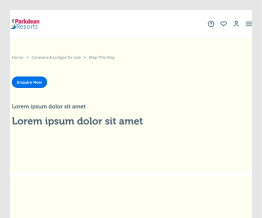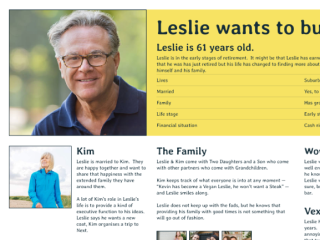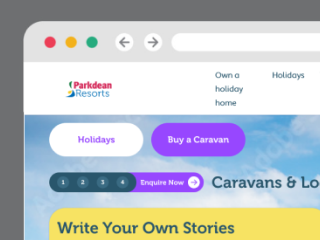Brief
Design a journey through the Parkdean Resorts website to sell Holiday Homes more effectively.
My Contributions
- Research & Discover
- Ideation
- Information Architecture
- Service Design
- Product Design
- Visual Design
Project Team
- Michael Wood User Experience
- Charlotte Product Owner
- Karen Business Analysis
- Adam Development Manager
- Jamie Testing
Process Overview
- Discover
- Research
- Analysis
- Wireframing
- Prototyping
- Development
Research & Discover
The project started off with my running Three-Sixty interviews around the Head of Holiday Home Sales, Sales People, Existing Customers, Potential Customers and Holidaymakers in order to make a state of play analysis Parkdean's existing relationship with the market.
Benchmarking followed as I conducted extensive analysis on similar product journeys for both selling holiday homes, and for comparable big ticket items. The used car market was an interesting parallel, and I learned from the disruption to that through Cazoo. Airbnb's disruption of the hotel market was also of note.
I also aggregated a lot of user data from the journey through the website and mapped out the tendencies for successful paths, noting what they read, what pages they dwelled on, and what interested them as well as what bumps and pain points they had on their journey.
Key Insights
Parkdean Resorts, in keeping with much of the commercial world, exists in a low trust environment where even the obvious values of products are questioned.
The response of "Of course they would say that" was common to even the most trivial claim made about the product, to the point where any voice coming from a source which was seen as "official" was de facto not believed.
In contrast, social proof had over influence, with any voice perceived as independent, or to have more independence, assumed to be honest.
Problem Statement
People who use our website found the Holiday Home Sales pitch too cold, not informative and too similar to the Holiday Sales process. This is a problem because it deters people from making enquiries.
People who use our website were not informed about practical elements of Holiday Home Ownership. These elements include things like running costs, and ground rent, and restrictions around when and what a Holiday Home can be used for. This led to people setting unrealistic expectations for what they could afford and do with their Holiday Home. This is a problem people felt they had been subject to a "bait and switch" which - when the information was provided earlier in the process - could be avoided, leading to improved conversions.
On-Park Sales Team Members found that customers who came through the Holiday Home Sales website were ill prepared for the realities of Holiday Home Ownership. These people were frequently deterred by simple propositions which could have been addressed by information on the website. This is a problem because an appointment On-Park was wasted, and there was a significant cost value to those appointments.
Assets
- [CF] Personas
- [F] Journey Maps
- Wireframes/Prototypes
- Interactive Prototypes
- [C] Designs
Ideation Phase
- Four day workshop to create ideas around a solution, drawing on the domain expertise of colleagues.
- Interviews with our Holiday Home Owners around the emotional triggers for their purchases, as well as the path they went on to make that purchase.
- Interviews with people who fit the profile of our owners, but were not convinced to own.
- Created mapped out a series of personas for people who use the website.
- Mapped journeys to show where people are leaving the sales pipeline, and where they missed information which would lead to a walkout from an appointment.
- Feedback and interactive improvement interviews formed around the current journey, and around wireframes, and later a prototype.
The Concept
A journey through the Parkdean Resorts website, which gives people the information they need to prepare themselves for an on-site meeting with one of our sales people.
Personas
Wireframe/Prototypes
 Building Wireframes in Figma allows a flow along the UX pipeline.
Building Wireframes in Figma allows a flow along the UX pipeline. Laying out highlights where information is needed.
Laying out highlights where information is needed. Creating work which can be used to get buy in across stakeholders.
Creating work which can be used to get buy in across stakeholders. Wireframes become Prototypes which are mapped onto the journey.
Wireframes become Prototypes which are mapped onto the journey. Areas in which content is needed are highlighted.
Areas in which content is needed are highlighted. While issues around the assumptions made on one screen size are highlighted on others.
While issues around the assumptions made on one screen size are highlighted on others. As the journey is defined the project can win buy in across stakeholders.
As the journey is defined the project can win buy in across stakeholders. As well as being used to illustrated to developers where their work may follow.
As well as being used to illustrated to developers where their work may follow. The final wireframes have a layer of branding added.
The final wireframes have a layer of branding added. As well as imagery to illustrate the visual tone.
As well as imagery to illustrate the visual tone.
Interactive Prototypes
- Prototype One First version
- 375px Prototype Two
- 834px Prototype Two
- 1,512px Prototype Two
Visual
User Testing
- KPIs for the journeys mapped through the website.
- Feedback reviews with sales people around the leads generated by the journey, focusing on what information people asked about during those sales meetings.
- Feedback questionnaire loop for people who went to expressed an interest in becoming an owner.
Features
- Improved journey, to educate people in how to be better Holiday Home Buyers.
- Better information, to tell people the financial realities of Holiday Home Owner.
- Improved imagery, to allow people to see something of themselves in the site.
Outcome
An improvement in more informed leads, and a decrease in walkaways from sales appointments.
Final Thoughts
Holiday Home Sales were not primarily about generating leads, it is about generating informed, prepared leads.
Excessive low quality leads caused problems when people who are put off from making a purchase by surface information only find that information in the context of a four hour on-park appointments run by our Sales Professionals, wasting everybody's time.
The key to making high quality leads was transparency in cost, in lifestyle, and in the process.



